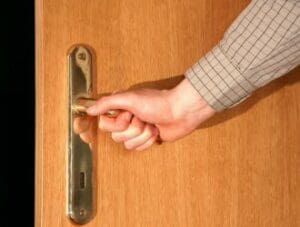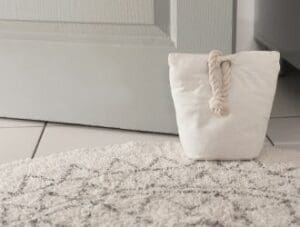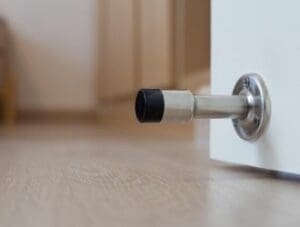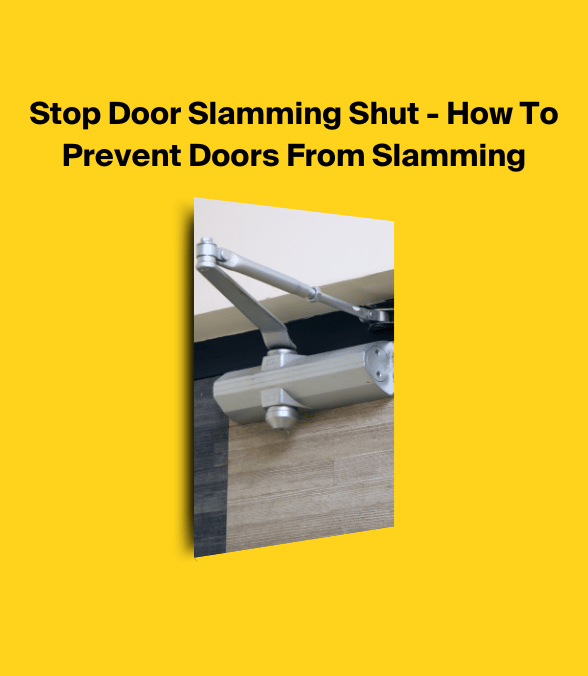How to Stop Doors from Slamming?

Fed up with doors slamming shut in your home or office?
Door slamming isn’t just loud; it also wears down your doors and can be a safety hazard.

Build your door today!
Get a Quote
Here, discover concrete solutions for preventing door slamming.
Implement them easily without disturbing the peace or compromising your door's integrity.
Stop Doors Slamming - In Summary
- Door slamming can be caused by user action, strong air currents, technical issues with the door, improper hinge installation, and door damage, such as warping.
- Solutions to prevent door slamming include assessing and fixing door conditions, installing hardware such as hydraulic door closers, soft-close hinges, door cushions or bumpers, and DIY fixes like weatherstripping and felt pads.
- Additional safety measures, such as pinch guards and door stops, should be installed in homes with children to prevent door slamming and avoid potential injuries to small fingers.
What Causes Door Slamming?
When doors slam and make a loud bang, we can all agree that it is incredibly annoying and needs to be solved as soon as possible.
Understanding why doors slam shut can help you fix the issue so you don't have to listen to it anymore.
Door slamming is a common household issue that can be triggered by various factors, often referred to as the door slamming problem. It could be the result of:
- strong air currents
- technical issues with the door
- improper hinge installation
If you’ve ever left a window open on a windy day, you’ve probably experienced the sudden and startling sound of a door slamming shut. This is a classic example of how strong air currents force a door to close abruptly.
Technical issues with the door or incorrectly installed hinges can also lead to uncontrollable door movement and slamming.
Assessing the Condition of the Door
Assessing the door’s condition is a necessary step before attempting to prevent doors from slamming.
This step will help you identify the cause of the problem and select the appropriate solution. For instance, the door hinges are the first component to inspect when your door slams shut.
Old doors that have not been adequately maintained are more prone to slamming shut due to warping or other age-related alterations.
You can learn more about hinges and how to fix them with our composite door hinge adjustment guide.
Check for Warping or Damage
Warping or damage in the door may cause it to slam. To identify if your door is warped or damaged, assess its fit within the door frame or seals.
An irregular shape could indicate warping or damage. If you notice any of the following, it’s likely that your door is damaged or warped:
- Distortions in the wood
- Splitting or cracking
- Door expansion or swelling
- Gaps in the frame
Once damage or warping is detected, your door will likely need to be repaired or replaced before any further changes to the door frame are made to curb the loud noise from door slamming.
Examine Alignment and Hinges
Misalignment of hinges can also result in door slamming. If the door isn’t properly aligned, it might hang at an angle and move on its own, closing harshly due to air pressure.
To check if the hinges are responsible for the door slamming, follow these steps:
- Open the door to a 90-degree angle.
- Place a level against the latch.
- If the level indicates that it isn’t perfectly level, try tightening the screws in the hinges.
If tightening the screws doesn’t stop the door from slamming shut, hinge replacement may be the next course of action. You can begin by:
- Unscrewing the top hinge.
- Continuing with the remaining screws.
- After replacing it, use a level to ensure it is plumb before screwing in the door.
- Repeat the same process for the middle and bottom hinges.
If the door still slams, consider adding a door jamb cushion to absorb the impact.
Prevent Doors Slamming
After identifying and addressing any door-related issues, consider various hardware options that can inhibit door slamming. These include hydraulic door closers, soft-close hinges, and cushions or bumpers.
Each of these devices works uniquely to slow the closing process, reducing the likelihood of a door slamming shut.
Hydraulic Door Closers
Hydraulic door closers are one of the most effective solutions to prevent door slamming. These closers can help protect doors from damage and reduce noise.
They utilise air or oil pressure to regulate the closing mechanism, ensuring a gradual and smooth door closure instead of an abrupt slam.
Installing automatic door closers, such as hydraulic and pneumatic ones, is relatively straightforward, making them a convenient solution to prevent door slamming.
Additionally, many hydraulic door closers can manually adjust the pressure, allowing them to be customised to the specific needs of various doors.
However, hydraulic door closers can be somewhat expensive, so this should be taken into account when selecting a door closer to prevent door slamming.
Soft-Close Hinges
Soft-close hinges, also known as anti-slam door hinges, are another great solution for preventing door slamming.
These hinges contain a hydraulic damper that slows the door’s closing speed, resulting in a gentle closure instead of a loud slam.
There are various soft-close hinges available for different applications, such as cabinet hinges with multiple opening angles, self-closing hinges, hidden hinges, and heavy-duty hinges.
The installation ensures the hinge is properly positioned squarely with the door edge and then secured. If your door has existing hinges, you can use a soft-close adapter bracket for retrofitting.
Remember that while soft-close hinges tend to prolong the lifespan of doors and drawers, they usually have a higher price point than standard hinges.
Door Cushions and Bumpers
Door cushions and bumpers offer a simple and effective way to prevent doors from slamming.
These devices are strategically placed on the wall or door frame to absorb the impact when a door is forcefully closed, minimising damage to the wall and reducing noise.

A wide range of door cushion products includes plush velvet draught excluders and weighted draught cushions.
To prevent slamming, install door cushions by affixing small felt pads along the edge of the doorframe at key locations.
These include the top, bottom, and near the strike plate.
Similarly, you can install door bumpers by using basic spring or solid baseboard-mounted door stops.
Alternatively, apply felt pads and foam strips directly to the door or frame.
DIY Fixes for Door-Slamming
A little bit of DIY can always be handy, so there are some solutions that you can use without having to call a professional.
If you prefer hands-on solutions, you might want to attempt some DIY remedies for door slamming. Two practical solutions include the installation of weatherstripping and the placement of felt pads.
These methods can be quite effective and require very little investment in time or money.
Weatherstripping Installation
Weatherstripping is a material strip, typically rubber, installed around doors to provide a tight seal.
It helps prevent door slamming by minimising the entry of air that could push the door shut and dampening the impact noise.
The installation of weatherstripping is a straightforward process. Here are the steps to follow:
- Open the door.
- Clean all the frames to remove any dirt or dust.
- Apply the self-stick rubber foam weatherstripping, which can be purchased at any hardware store.
Weatherstripping is useful for preventing door slamming, improving insulation, and preventing drafts.
Felt Pad Placement
Another simple DIY remedy to prevent door slamming is affixing felt pads to the door or frame. These pads absorb the impact and noise of shutting the door, preventing it from slamming.
The recommended placement for felt pads is along the edge of the doorframe. For optimal effectiveness, position a pad at the top and bottom of the frame and additional pads along the sides where necessary.
It’s especially beneficial for lighter doors, such as uPVC doors.
However, for solid-core doors, it is advisable to consider using weatherstripping as an alternative. In most cases, a few felt pads will suffice.
Child-Proof Doors to Stop Slamming
Doors slamming is already an annoying problem, but it can be even worse if you have children in your home.
If young children are in your household, extra precautions to prevent door slamming will be necessary. Little fingers can easily get caught in slamming doors, leading to painful injuries.
Employing pinch guards and door stops are two practical measures to child-proof doors and keep them from slamming.
Pinch Guards
A pinch guard is a safety device designed to prevent a door from closing completely. It serves as a child-proofing measure to minimise door slamming and reduce the risk of injuries.
Pinch guards work by physically obstructing the door from fully closing, thus safeguarding fingers from being pinched or trapped and ensuring safety, particularly for children.
There are various pinch guards available for different door types, such as automated doors, fire doors, and swing doors, effectively addressing diverse safety requirements.
Door Stops
Door stops are small pieces of metal or plastic affixed to the wall that limit the door’s range of motion, thereby preventing door slamming.
They can be made from shock-absorbing materials like silicone, plastic, or rubber, which not only prevent doors from slamming but also protect children from injuries.
Installing door stops involves the following steps:
- Open the door until it is parallel to the wall.
- Mark the point on the baseboard that lines up with the edge of the door.
- Mark the wall or skirting where the door stopper or mounting plate will be positioned.
Stop Doors from Slamming - Our Thoughts
With this guide, you should hopefully know more about door slamming and how various factors, such as intentional slamming, strong air currents, technical issues, and improper hinge installation, can cause it.

Assess the door's condition by checking for warping or damage and examine the alignment and hinges.
This will help you identify the cause and choose the appropriate solution.
Several hardware options, such as hydraulic door closers, soft-close hinges, and door cushions or bumpers, can prevent door slamming.
DIY fixes like weatherstripping installation and felt pad placement can be quite effective.
For households with children, consider child-proofing doors with pinch guards and door stops.
Frequently Asked Questions
What can I put on my door to stop it from slamming?
You can attach a rubber or foam door stopper to prevent the door from slamming.
How do you make a door not slam so loud?
To prevent a door from slamming too loudly, you can use felt pads and foam strips, adjust the door closer, or install a door stopper or a pinch guard.
These methods can help reduce the impact and noise when the door closes.
How do you soundproof a door slamming?
You can soundproof a door from slamming by using acoustic panels. These panels come in various materials and can be attached to the door to reduce the amplitude of sound waves.
What is the significance of evaluating the condition of the door?
Evaluating the condition of the door is important as it aids in pinpointing the cause of the door-slamming problem and selecting the most suitable solution.
This assessment can help address the issue effectively.
How do I install a hydraulic door closer?
Installing a hydraulic door closer is straightforward and can be adjusted to fit the specific needs of different doors. Just follow the instructions carefully for a successful installation.









